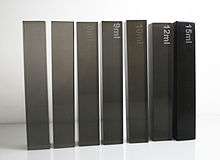Cast acrylic



A type of making acrylic when single sheets are made by pressing the liquid plastic between pieces of a mold, often made of glass, which is then taken through a gradual heating process.
Advantages
It has better thermal stability, higher resistance to crazing (when a network of very small cracks form) when exposed to solvents, wider thermoforming range than extruded acrylic. Cast acrylic has better ability to be reworked hot and it is known for its superior surface finish and optical properties. Also cast acrylic is more scratch resistant than extruded acrylic. Cast acrylic is also preferred over extruded in applications that require machining, such as turning on Engine Lathe or milling/drilling. Extruded acrylic, with far less thermal stability, tends to melt and clog cutting tools. Even with slow speeds and lots of coolant, extruded acrylic does not produce the surface finish and tight tolerances achievable with cast acrylic.
Usage
This type of acrylic is often used for aquariums, awards, financial tombstones, trophies, corporate gifts, and other products that require shaping or machining. It tends to be more clear and made to a higher quality standard, but in doing so makes it more expensive than extruded acrylic.
References
http://www.cutplasticsheeting.co.uk/clear-acrylic-sheeting/clear-cast-acrylic.html http://www.bit-tech.net/modding/2008/03/14/a_modders_guide_to_acrylic/1 http://www.pmma.dk/Acryl_stobt_kontra_ekstruderet.aspx?Lang=en-GB